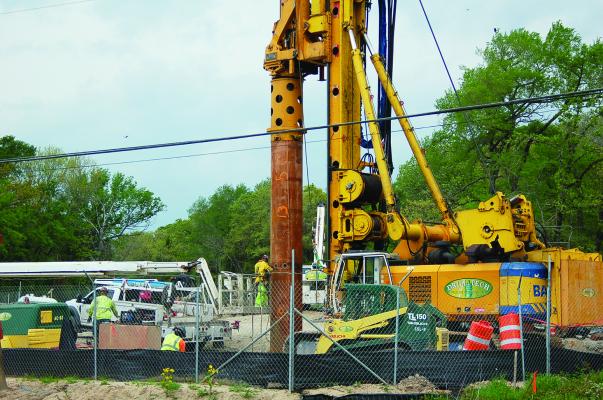New Cedar Creek Lake pipeline explained
Previous state permit sets max water draw
Monitor Photo/Russell Slaton
In late March, workers continue construction beside State Highway 31 where the Integrated Pipeline section from Lake Palestine will bore under the highway in west Malakoff. The pipeline also will go under a nearby railroad.
CEDAR CREEK LAKE–Tarrant Regional Water District (TRWD) spoke with The Monitor April 10 about questions the newspaper has received about the effect a new pipeline will have on Cedar Creek Lake.
The Integrated Pipeline (IPL), which is a $2.3 billion joint venture between TRWD and City of Dallas Water Utilities, has had the ability since 2022 to take water from Cedar Creek Lake (CCL) – to which TRWD has water rights -- and should by 2027 move water from Lake Palestine – to which Dallas owns rights – bringing millions more gallons of the precious resource to the Metroplex.
TRWD Water Resources Engineering Director Zach Huff said current construction in the Malakoff area is the portion of the pipeline that will bring water from Lake Palestine. That part of the project generally cuts diagonally through southern Henderson County.
The IPL also includes a connection to Richland-Chambers Lake (RCL), for which TRWD also has water rights. Huff said the RCL connection to the IPL opened in 2018 and offers redundancy to RCL’s older pipeline built in the 1980s. Huff added that the RCL connection splits off from the 1980s pipeline to put water into the IPL, altogether allowing water to move from RCL “much more efficiently.”
The RCL connection doesn’t yet increase the amount of water drawn from RCL, according to TRWD’s Huff. A future IPL phase will allow TRWD to utilize the fully permitted RCL water allowance when needed, the TRWD engineer said.
Cedar Creek Lake’s flow into the pipeline became functional in spring 2022, Huff shared. The pipeline increases TRWD water but is limited by a Texas Commission on Environmental Quality permit to an annual total of 175,000 acre-feet of water, the same maximum as before the new pipeline, according to Huff.
One hundred percent of that allowance – which the new pipeline allows for if the water district needs it, according to Huff – works out to a maximum of 156 million gallons per day if the system pumped constantly at full capacity every day of the year, the engineer said. Water needs for Dallas and Tarrant will be fulfilled by the three lakes’ total capacity entering the IPL, Huff said. Water from the three lakes will meet in the pipeline near Kerens, in Navarro County, he shared.
Cedar Creek Lake’s connection to the IPL is in addition to the original CCL pipeline from the 1970s, Huff said. Before IPL’s construction, TRWD was taking 83% of its state-allowed water allowance, he continued. That 83% calculates to 130 million gallons per day, said Huff. How low Cedar Creek Lake can go is not only guided by state-mandated maximums, but also physical constraints such as whether water pump intakes can still access water, Huff added.
The Monitor will run more details from its TRWD interview which further explain the pipeline and its effect on Cedar Creek Lake and area reservoirs in next Thursday’s edition.




